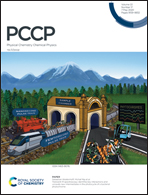What does carbon tolerant really mean? Operando vibrational studies of carbon accumulation on novel solid oxide fuel cell anodes prepared by infiltration†
Abstract
Operando Raman spectroscopy and electrochemical techniques were used to examine carbon deposition on niobium doped SrTiO3 (STN) based SOFC anodes infiltrated with Ni, Co, Ce0.9Gd0.1O2 (CGO) and combinations of these materials. Cells were operated with CH4/CO2 mixtures at 750 °C. Raman data shows that carbon forms on all cells under operating conditions when Ni is present as an infiltrate. Additional experiments performed during cell cool down, and on separate material pellets (not subject to an applied potential), show that chemically labile oxygen available in the CGO infiltrate will preferentially oxidize all deposited surface carbon as temperatures drop below 700 °C. These observations highlight the benefit of CGO as a material in SOFC anodes but more importantly, the value of operando spectroscopic techniques as a tool when evaluating a material's susceptibility to carbon accumulation. Solely relying on ex situ measurements will potentially lead to false conclusions about the studied materials’ ability to resist carbon and improperly inform efforts to develop mechanisms describing electrochemical oxidation and material degradation mechanisms in these high temperature energy conversion devices.



 Please wait while we load your content...
Please wait while we load your content...